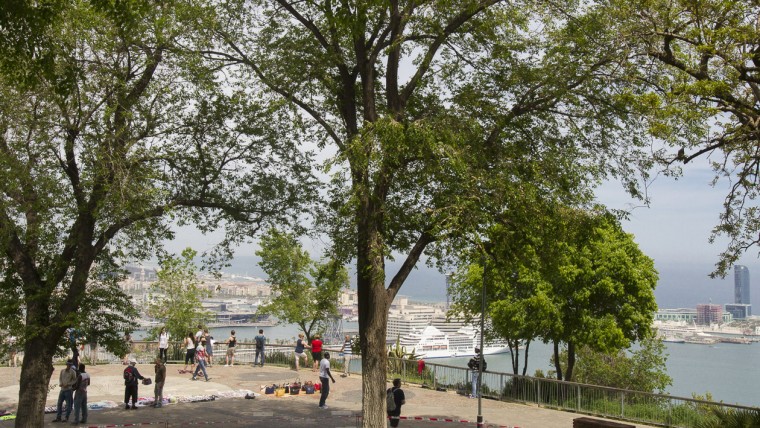
The Mirador de l’Alcalde (Mayor’s Viewing Point) is divided into landings that take advantage of the steep slope. The levels are connected by flights of stairs and gently sloping parterres, separated by a paving that is part of Barcelona’s artistic heritage.
An ornamental fountain in a pool at the centre of the park, from where the paths, parterres, plants and resting areas radiate out, pours water onto small platforms that form a cascade which ends up in the lower pool, with an ornamental fountain too

History
This arrangement is very evident at the Mirador de l’Alcalde. The first-level entrance connects to the large esplanade at the very top of the Joan Brossa Gardens, while the entrance giving direct access to the third level of the Mirador de l’Alcalde is located near one of the stations for the cable-car that goes up to Montjuïc Castle.
General Franco turned Montjuïc Castle over to the city in 1960, on condition that it housed a military museum, among other things. This, aside from adapting the castle for new uses, led to and boosted the development and landscaping of the areas around the monument and the Miramar area in general.
Work began in 1962 and was carried out in several stages up to 1969, the year of the gardens’ official opening, when José María de Porcioles was the city’s mayor. Porcioles commissioned Carles Buïgas, the creator of the Magic Fountain, with designing the fountain at the centre of the park.

Art and Architecture
This is a 420 m2 mosaic designed by Joan Josep Tharrats. It was made out of materials as varied and original as pebbles, paving stones, bricks, tiles laid edgewise, bottle bottoms, pieces of concrete, different pieces of iron (chains, cogs, filaments, screws and bolts, sheet metal from obsolete machines) and fragments of manhole covers from urban subsoil services, among other things.
-
- Phone number
- Tel.: 010
-
- Titularity
- Public center
- Address:
- Carretera de Montjuïc, 41 - 51
- Districte:
- Sants-Montjuïc
- Neighborhood:
- el Poble-sec
- City:
- Barcelona
Timetable
| Periode | Dies | Hores |
|---|---|---|
Horari d’hivern: de l'1 de novembre al 31 de març |
Cada dia | de 10:00 h a 19:00 h |
Horari d'estiu: de l'1 d'abril al 31 d'octubre |
de 10.00 h a 21.00 h |
aproximat, es tanca al
capvespre,quan es fa fosc.

